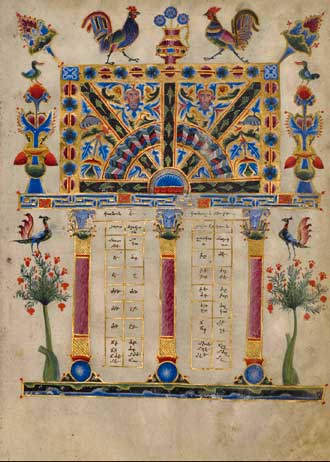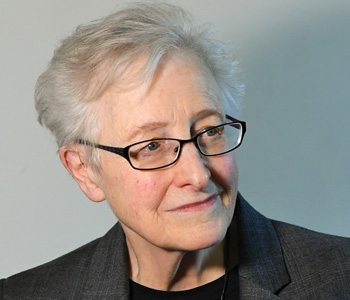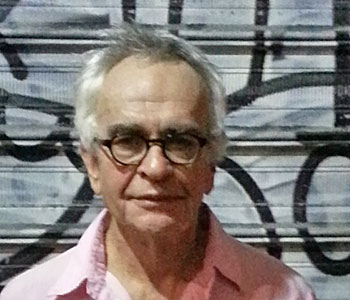Heghnar Zeitlian Watenpaugh
The Missing Pages: The Modern Life of a Medieval Manuscript, from Genocide to Justice
Stanford University Press
436 pages, 6.2 x 9.2 inches
ISBN 978 0804790444
In 2010, the world’s wealthiest art institution, the J. Paul Getty Museum, found itself confronted by a century-old genocide. The Armenian Church in Los Angeles was suing for the return of eight pages from the Zeytun Gospels, a manuscript illuminated by the greatest medieval Armenian artist, Toros Roslin. Protected for centuries in a remote church, the holy manuscript had followed the waves of displaced people killed during the Armenian genocide. Passed from hand to hand, caught in the confusion and brutality of the First World War, it was cleaved in two. Decades later, the manuscript found its way to the Republic of Armenia, while its missing eight pages came to the Getty in California.
The Missing Pages is the biography of the Zeytun Gospels, a medieval manuscript that is at once art, sacred object, and cultural heritage. The book follows in the manuscript’s footsteps through seven centuries, from medieval Armenia to the killing fields of 1915 Anatolia, the refugee camps of Aleppo, Ellis Island, and Soviet Armenia, and ultimately to a Los Angeles courtroom. The story of how the pages came to be missing unfolds the entire tragic history of the Armenian people in the 20th century.
The tale of this beautiful and meaningful object and its extraordinary journey embody some of the defining elements of art history in the 21st century. I take the much-publicized legal battle as a point of entry to explore how contests over art objects are framed, what cultural heritage signifies to survivor communities, and how institutions like museums curate and display works of art with painful histories.
Reconstructing the path of the pages, I sought to uncover not only the rich tapestry of an extraordinary artwork, but also the individuals and communities touched by it. At once a story of genocide and survival, of unimaginable loss and resilience, The Missing Pages captures the human costs of war and persuasively makes the case for a human right to art.
The intentional destruction of cultural heritage in peace and war, the looting of artifacts and their trafficking by criminal networks, as well as contests over the ownership, function, and meaning of art, occupy newspaper headlines and constitute the pressing issues of cultural heritage today.
In 2015, for instance, the self-proclaimed Islamic State (ISIS or ISIL) turned the destruction of art into mass spectacle. Its operatives filmed the destruction of art in the Mosul Museum and the blasting of the Temple of Bel in Palmyra, then edited the film into highly curated videos that were then amplified through social media to manipulate public perception and instill outrage and terror. Meanwhile, the wealthiest people in the world have resorted to opaque financial acrobatics involving offshore businesses and shell companies to conduct semi-legal or illegal trade in art that evades scrutiny and confuses restitution claims. Western museums display, and auction houses put up for sale, objects that were illegally excavated or unlawfully removed from places of worship, that entered circulation on the art market due to war, colonialism, civil unrest, atrocities, or sheer desperation. In some instances, museums have been forced to return unlawfully acquired objects, often in the wake of litigation or negotiation.
Although the recent acts of cultural destruction and looting have reverberated around the world, similar practices have a long and fraught history. In the Middle East, they have been entwined with colonialism, empire building, and nationalism. They have also intersected with the mass extermination of civilian populations by their own states—ethnic cleansing, massacre, and genocide. These episodes still cast a long shadow, not only in the Middle East but beyond, in the diasporas where children of refugees seek to remake their communities. The repercussions of assaults on cultural heritage endure in the struggles for the restitution, repatriation, and reunification of art or sacred objects with their communities or countries of origin. We not only have to come to terms with the immediate implications of the destruction of heritage that we witness in our own time, but we also have to grapple with the long-term consequences of the destruction of culture and its many afterlives. Moreover, we need to understand how the experience of looting or destruction shapes the object itself, and its role in the social world.
Accounts of the destruction of art or the restitution of cultural heritage often highlight the zealous breakers of images, opportunistic looters, daring thieves, clever accountants, courageous archeologists, dedicated journalists, honest policemen, resilient librarians, undaunted art historians, acquisitive collectors, careful curators, uncaring oligarchs, and heroic lawyers. They prompt questions such as: Who owns or should own antiquities? When is art unlawfully taken, and when should it be restituted? How should museums ethically build collections? What best serves the public good without infringing on rights?
These questions all deserve answers. Yet they leave much of the object’s story untold. A treasured artwork, the image of a deity, or a holy book is a material entity launched into a web of social relationships. The story of a trafficked object and of its people shows us at eye level the experience of art, which legal notions and treaties about the human right to culture seek to enshrine in law. It shows us how central art is to resilience and survival.
When I first heard about the lawsuit, it resonated with me in many ways. I am an art historian, I had been a Getty Fellow, and the Armenian Genocide is part of my family history. As the lawsuit was winding its way through legal procedures and court filings in Los Angeles, I decided to go on a quest, to retrace the steps of the Zeytun Gospels, from the site where it was created through all the known stations on the journey that eventually took the manuscript to Yerevan, Armenia, minus its eight missing pages that ended up in Los Angeles. I hoped to gain a fuller understanding not only of the manuscript itself and of its history, but also of the places, landscapes, and even ruins where the Gospels had spent time during its itinerary. I hoped to learn something of how the Gospels and its communities had interacted in specific places, and how the genocide and its long-term effects had transformed these sites.
The book is structured along this “quest,” where each chapter considers a city or site where a key moment in the manuscript’s life unfolded. In the overall arc of book, the central character is the Gospels. Yet each chapter can stand on its own. Those who are passionate about medieval sacred objects can delve into the chapter on Hromkla, the castle on the Euphrates River not far from the Mediterranean, where the artist Toros Roslin created the Zeytun Gospels for his patron, the Catholicos of the Armenian Church, the great bibliophile Constantine I. Those who want to know more about the genocide and the destruction of culture will be drawn to the chapters that retrace the steps of the holy book through some of the most terrible atrocities of World War I and the Armenian Genocide. And those who love courtroom dramas and restitution battles can focus on the final chapter on Los Angeles, that follows the lawsuit and its players and places it in the context of the restitution movement for the Armenian Genocide, which was modeled in many ways on the recent wave of Holocaust Restitution.
Even the book’s illustrations are carefully curated and sequenced to tell a stand-alone story through narrative captions.
Toros Roslin, Canon Tables from the Zeytun Gospels, 1256, J. Paul Getty Museum, Ms. 59. Digital image courtesy of the Getty’s Open Content Program.

The last decade has seen the transformation of the public debate about cultural heritage, art and its intentional destruction, the responsibilities of museums, and the challenges of restitution. The Missing Pages builds on these debates. It uses the litigation in Los Angeles and the gripping story of a single manuscript, to delve into these complex and overlapping issues in a substantive way.
Questions of restitution will likely increase and become more pressing worldwide in the future. I believe we will see more struggles between powerful institutions and communities over the control of cultural patrimony. American museums have already had to change the way in which they react to these challenges — the public today is showing little tolerance of the condescending, tone-deaf, and Eurocentric attitudes that used to be common. Many tensions remain, however, as we are seeing in the debate on the proposed restitution of African art held by French museums that is unfolding now. I am heartened to see that some museums are taking proactive steps towards the whole issue of restitution; they are making great efforts at being inclusive and approachable, even decolonial, and some art museums are even integrating painful histories into their exhibitions in innovative ways. However, we still have a long way to go.
The book, I hope, will prompt deeper reflection and action on cultural heritage and human rights, as well as on the whole issue of restitution and reparation at all levels. There is no one-size-fits-all model. In the case of the Zeytun Gospels, a settlement was reached in 2015. The Getty acknowledged the Armenian Church’s historical ownership of the pages, and the church donated the pages to the Getty Museum. The ownership is acknowledged, the pages are preserved, and they are available to the public to view in Los Angeles, where as many as 500,000 people of Armenian extraction live, many of them descendants of survivors of the Armenian Genocide. In this case, both sides made concessions, and both sides achieved some of their original goals. The art press hailed the settlement as an important precedent in disputes between museums and religious communities. However, it is also critical to acknowledge that there are tremendous asymmetries of power and that restitution and reparation are very difficult to achieve in most cases. For the Zeytun Gospels, there could not be a return to the past, and the injuries of war and genocide can never be repaired. Ultimately, the greatest impact of settlements like this is that they help develop greater collaboration between museums and communities over the appreciation of works of art and the telling of difficult histories.




We don't put paywalls. We don't distract you with ads. We don't sell your data.
Please help to keep this running!